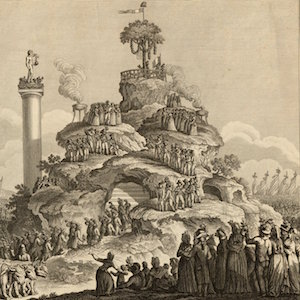Europe

Louis’s Separation from His Family
After hearing the verdict, the King was allowed a final evening with his family, whom he had not seen for almost a month during the trial. Twice on the evening of 20 January the King met with his wife, his son, and a daughter. For about an hour and three–quarters all told, they visited.

Image of the King on Trial
When he was charged, the King could have simply refused to participate on the grounds that the extant Constitution promised his immunity. But this defense, he knew, was useless and he elected to stand on his record.

Louis as Pig
The Queen, never popular to begin with in France, also bore the brunt of popular anger in 1792, as seen in these images of the King, the Queen, and elsewhere the entire royal family, as animals.

Marie Antoinette as a Serpent
The Queen, never popular to begin with in France, also bore the brunt of popular anger in 1792, as seen in these images of the King, Queen, and elsewhere the entire royal family, as animals.

Image of the Attack of 20 June 1792
By the spring of 1792, the Revolution was in crisis on several fronts—in April, war had been declared on the Habsburg Empire, uprisings were taking place in provincial cities, and the Legislative Assembly was increasingly divided over whether to consolidate gains already made or press forward wit

The King Accepting the Constitution amid the National Assembly, 14 September 1791
The Estates–General, reborn as the National Assembly, finished its work by completing a new constitution. This document provided for an executive—the King—as well as a legislative body. Suffrage was male and restricted to certain economic levels.

View of the Mound of Champ de la Reunion
In this watercolor of the Festival of the Supreme Being, we see a procession that includes a woman wearing a Phrygian cap paraded past a statue of Hercules holding two smaller statues of Liberty and Equality, towards a Liberty tree, atop the hill.

Entry of the French into Holland
From Berthault’s series of great moments of the Revolution, this engraving depicts the victorious entry of the republican French forces into the southern Netherlands (currently Belgium) on 21 January 1795, where a "sister republic" of Batavia would soon be established.

Battle of the Pyramids
After a six–week journey from France, the army of some 38,000 arrived in Egypt. The French stormed and took Alexandria first, then moved up the Nile toward Cairo.

Costumes of the Council of Five Hundred
In this bicameral legislature, the smaller of the two councils (the Elders with 250 members) had to pass all the legislation, while the Five Hundred could initiate legislation. The revolutionaries decided on the division of authority.